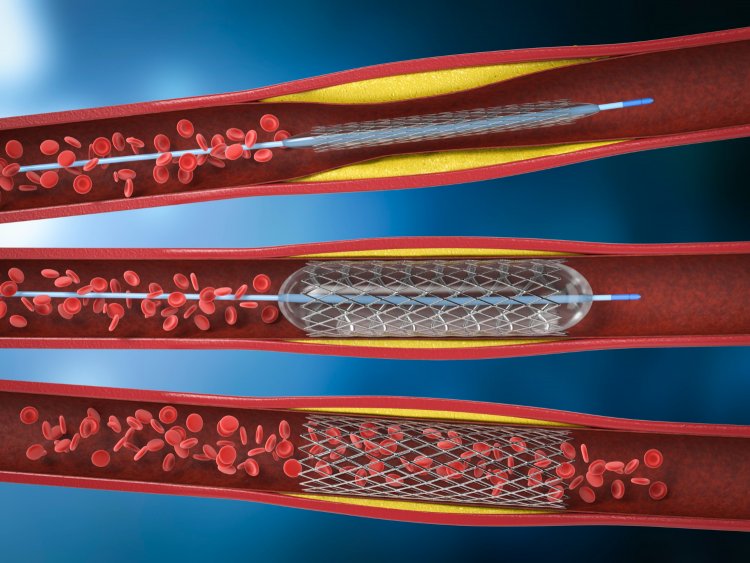Angioplasty and Stent Placement: Advancements in Cardiac Care
Cardiovascular disease, particularly coronary artery disease (CAD), is a leading cause of death globally. Treatments have evolved significantly over the past few decades, with angioplasty and stent placement being among the most critical interventions. These procedures have transformed the management of heart disease, offering minimally invasive solutions to restore and maintain blood flow to the heart muscle.

Understanding Angioplasty
Angioplasty, also known as percutaneous coronary intervention (PCI), is a technique used to widen narrowed or obstructed coronary arteries. This procedure is essential for patients experiencing angina (chest pain) or those who have suffered a heart attack due to blocked arteries.
The Angioplasty Procedure
Preparation:
Pre-procedure Testing: Patients typically undergo diagnostic tests such as an electrocardiogram (ECG), echocardiogram, or coronary angiography to assess the extent of artery blockages.
Medication Management: Blood thinners and antiplatelet drugs are often administered to reduce the risk of clot formation.
Accessing the Artery:
A catheter is usually inserted through the femoral artery in the groin or the radial artery in the wrist. The choice of access site depends on the patient’s anatomy and the cardiologist’s preference.
Navigating to the Blockage:
Using real-time X-ray imaging (fluoroscopy), the catheter is carefully guided through the vascular system to the site of the blockage in the coronary artery.
Inflating the Balloon:
A balloon-tipped catheter is advanced to the blockage site. The balloon is then inflated, compressing the plaque against the artery walls and expanding the artery lumen.
Deflating and Removing the Balloon:
After sufficient dilation, the balloon is deflated and withdrawn, leaving the artery widened.
The Role of Stent Placement
While angioplasty can open a blocked artery, there is a risk of re-narrowing (restenosis). To mitigate this risk, stent placement is often performed in conjunction with angioplasty.
Types of Stents
Bare-Metal Stents (BMS):
These stents provide structural support to the artery but do not release any medication. They were the first type of stents used and are less commonly used today due to higher rates of restenosis.
Drug-Eluting Stents (DES):
These stents are coated with drugs that inhibit cell proliferation, significantly reducing the risk of restenosis. The medication is gradually released over time, helping to keep the artery open.
The Stent Placement Procedure
Stent Deployment:
The stent, mounted on a balloon catheter, is positioned at the site of the artery blockage. When the balloon is inflated, the stent expands and locks into place against the artery wall.
Securing the Stent:
The balloon is deflated and removed, leaving the stent in place to maintain the artery’s openness. The stent acts as a scaffold, ensuring the artery remains patent.
Post-Procedure Care:
Patients are typically monitored for several hours or overnight to ensure there are no complications. Medications such as antiplatelets (e.g., aspirin and clopidogrel) are prescribed to prevent blood clots from forming within the stent.
Indications for Angioplasty and Stent Placement
These procedures are indicated for various conditions, including:
Acute Myocardial Infarction (Heart Attack):
Rapid intervention with angioplasty and stent placement can restore blood flow to the heart muscle, reducing damage and improving survival rates.
Chronic Stable Angina:
For patients with significant coronary artery disease who experience chest pain during exertion, these procedures can relieve symptoms and improve quality of life.
Unstable Angina:
In cases where chest pain occurs unpredictably or at rest, angioplasty and stent placement can stabilize the condition and prevent a heart attack.
Ischemic Heart Disease:
Angioplasty and stenting are also used in patients with significant artery narrowing, as detected by stress tests or imaging studies, to prevent future cardiac events.
Benefits of Angioplasty and Stent Placement
The primary benefits include:
Minimally Invasive: Unlike open-heart surgery, these procedures are performed through small punctures in the skin, resulting in less pain and quicker recovery.
Immediate Symptom Relief: Patients often experience rapid improvement in symptoms such as chest pain and shortness of breath.
Reduced Hospital Stay: Most patients can leave the hospital within a day or two after the procedure.
Lower Risk of Complications: Compared to traditional surgery, the risk of complications such as infection and prolonged recovery is significantly reduced.
Risks and Complications
While angioplasty and stent placement are generally safe, potential risks include:
Bleeding or Hematoma: At the catheter insertion site.
Blood Vessel Damage: Including dissection or perforation of the artery.
Restenosis: Re-narrowing of the artery, although this risk is significantly reduced with drug-eluting stents.
Stent Thrombosis: Formation of a blood clot within the stent, which can lead to a heart attack. Long-term antiplatelet therapy helps mitigate this risk.
Allergic Reactions: To the contrast dye used during the procedure.
Post-Procedure Care and Lifestyle Changes
Successful angioplasty and stent placement require adherence to a comprehensive post-procedure care plan, which includes:
Medication Adherence: Taking prescribed medications, particularly antiplatelet drugs, is crucial to prevent complications.
Lifestyle Modifications: Patients are encouraged to adopt heart-healthy habits, such as quitting smoking, eating a balanced diet, exercising regularly, and managing stress.
Regular Follow-Up: Routine check-ups with a cardiologist to monitor heart health and the status of the stent.
Conclusion
Angioplasty and stent placement are revolutionary procedures that have dramatically improved the prognosis for patients with coronary artery disease. By providing a minimally invasive solution to revascularize blocked arteries, these interventions have saved countless lives and enhanced the quality of life for many. As medical technology continues to advance, the safety and efficacy of these procedures will only improve, offering even greater benefits to patients worldwide.
Disclaimer
The information provided in this article is for educational purposes only and should not be considered medical advice. If you have any health concerns or are experiencing symptoms, it is important to consult with a healthcare professional, such as a doctor or clinic, for proper diagnosis and treatment. Always seek the advice of your doctor or other qualified health provider with any questions you may have regarding a medical condition. Do not disregard professional medical advice or delay in seeking it because of something you have read in this article.
#HealthCare #HeartHealth #Angioplasty #StentPlacement #Cardiology #MedicalAdvice
What's Your Reaction?





















